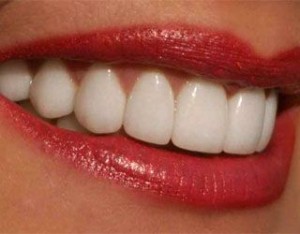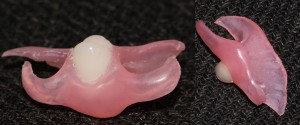Reviews on Nylon Dentures

Nylon dentures attributed to soft removable structures, characterized by lightness and flexibility.
Designs are made of dental nylon, the structure of which is identical to the gums and natural teeth.
Such prostheses have an excellent aesthetic component.
Fixation of nylon prostheses is carried out by attaching clasps made of the same material.
Benefits
- Designs made of nylon do not cause allergic reactions and therefore can be used if the patient has intolerance to materials such as acrylic plastic and metal.
- Reducing the period of the adaptation period to the design, due to the lightness and flexibility of the material.
- Fixation of the structure is highly reliable and does not require the use of various fixing preparations.
- There is no need to grind abutment teeth, as they do not need to be covered with crowns.
- High aesthetic performance of the prosthesis makes it invisible against the background of real teeth.
- The service life of the structure, with careful handling and compliance with all the recommendations of the attending physician, is from 5 to 7 years.
- A nylon denture is almost impossible to break.
- They are an ideal solution for prosthetics of one or two teeth.

Minuses
The disadvantages of nylon structures include the following:
- Care must be taken when caring for the denture. To clean them, use special tools, as When using ordinary brush and paste, the design is easy to scratch. As a result, such prostheses tend to actively absorb extraneous odors and change color when using colored liquids.
- When using the design due to its increased elasticity and flexibility, the likelihood of atrophy of the jawbone increases, which increases the risk of gum injury.
- Too high cost.
If you use a nylon prosthesis for a long time, you can get the following types of injuries:
- When fixing the clasps, during chewing, the load is not transmitted to the abutment teeth. As a result, mainly the marginal gum of the tooth is affected, which leads to periodontal inflammation.
- Due to the lack of a rigid frame, an uneven distribution of pressure on the gingival mucosa occurs. The greatest pressure falls on the gum section where the chewing process occurs, which over time can cause bone atrophy.
- As a result of atrophic changes, bone sagging under the prosthesis occurs. Gum subsidence of more than 2-3 mm requires correction or replacement. For a year of using the nylon construction, the gum sags by 1 mm on average.
To make the right final choice in favor of a nylon prosthesis, you should carefully weigh the pros and cons, as well as look for reviews of nylon dentures on the Internet and on the sites of dental clinics.

Reviews
Dentures made of nylon for a short period of use in dental practice have acquired both supporters and opponents.
In general, doctors respond positively to nylon designs, while patient reviews are quite controversial.
And this is due to the fact that the perception and adaptation to the foreign body of a single person is strictly individual, and, therefore, the conclusions of the patients are subjective.
- At 68, I lost most of my teeth because of my diabetes. When I went to the clinic, the dentist recommended installing a removable nylon prosthesis, since it was undesirable to put other prostheses. I have been using the construction for several months. At first it was unusual, I strongly felt the presence of a foreign body in my mouth. Then she began to get used to it and no longer remove artificial teeth for the night. If before I ate only pureed food, now I can eat a pear, an apple.
- By the age of thirty, what has usually happened to people of advanced age has happened. As a result of the accident, I was left without teeth. A lot of money was spent on treatment, so there was no question of installing implants. One of the criteria of my choice was the aesthetic side. After consulting with a dentist and studying the reviews of those who have already encountered similar problems, I opted for nylon prostheses. I’ve been using new teeth for several months now. At first I suffered a little with them: I took food only in mashed and boiled form, the design rubbed the gums to the blood. The doctor recommended the use of fixing agents so that the prosthesis holds better and does not rub the mucous membrane. Now I’m already used to it and even sometimes forget that the teeth are not real. The high esthetics of the prosthesis makes it invisible, the structure is well fixed and it is necessary to remove it only for hygienic processing.
- For five years, he used an acrylic prosthesis. What difficulties I had to endure! Constantly, the design slipped out of his mouth, had an unattractive appearance due to the fact that the hooks were visible during a conversation. A year ago, he installed a nylon prosthesis in order to somehow improve aesthetics. The design is light and completely invisible in the mouth. I got used to a new prosthesis for a long time, and two and a half months ago blackness appeared on artificial teeth. I had to hand over the removable structure for repair, where it was sanded and nylon was added. A week ago, a new problem appeared: the gums ached. Apparently, the entire life of the prosthesis will overcome difficulties.
- He installed a nylon prosthesis more than a year ago. Already on the day of installation, the construction rubbed the gum so that it was necessary to abandon its use. The dentist performed correction several times until the prosthesis sat normally on the gum. Now when I chew I don’t feel any discomfort, artificial teeth, like my own. The design does not interfere with smiling, talking at all.
- I installed a nylon prosthesis on one tooth two months ago. At first it was inconvenient to chew food, but now I’m used to it. The diction was two weeks disgusting: lisped very strongly. People pretend not to notice my artificial tooth. But it seems to me that anyway, it is noticeable against the background of other healthy teeth.